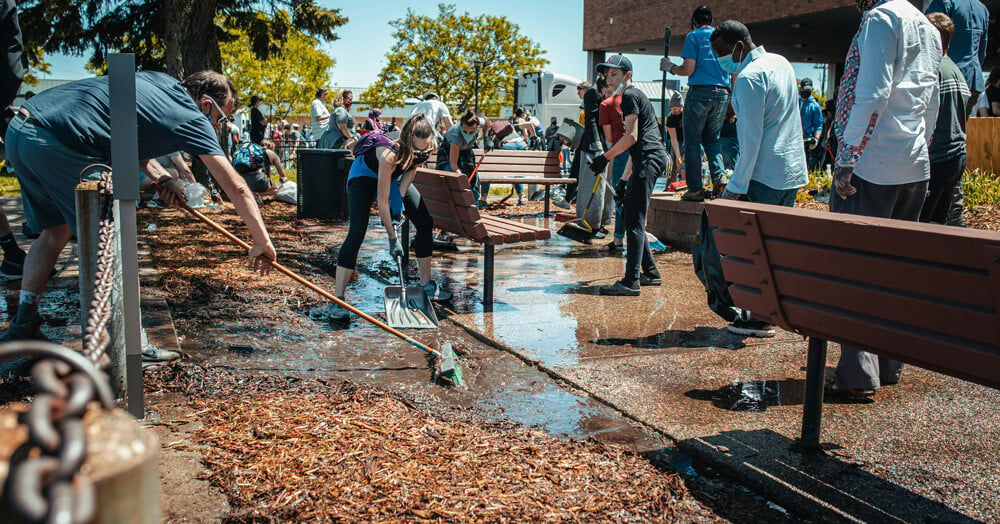5 Steps for Organizing a Community Clean-Up Event
Organizing a community clean-up event is a wonderful way to foster community spirit, improve local environments, and create a positive impact.
Utilizing software like Purplepass can also help streamline the process, making it easier to manage volunteers, gather RSVPs, and even accept donations. 
Step 1: Planning Your Community Clean-Up
Choose a Location: Start by identifying a public area in need of cleaning, such as parks, beaches, streets, or vacant lots. Visit the potential sites to assess the extent of the litter and any special needs, such as hazardous materials that may require specific handling. Ensure to get the necessary permissions from local authorities or property owners.
Assess Needs: Determine the scope of the clean-up and list the tools and supplies required, such as trash bags, gloves, rakes, shovels, and safety vests. Plan how the collected waste will be disposed of by coordinating with local waste management services for pick-up or identifying designated disposal sites. Consider the need for special equipment for handling large or hazardous items.
Set a Date and Time: Choose a date with favorable weather conditions to ensure a comfortable and safe environment for volunteers. Opt for a time that is convenient for most people, such as weekends or public holidays, to maximize participation. Check local weather forecasts and select a season or month known for mild and predictable weather.
Step 2: Promoting the Event
Promoting your community clean-up event effectively is crucial to ensure high participation and community involvement. A well-rounded promotional strategy includes creating engaging materials, utilizing social media, and engaging with local media.
Flyers and Posters: Design eye-catching flyers and posters that include essential details such as the date, time, location, and purpose of the event. Distribute these materials in high-traffic areas like community centers, schools, libraries, coffee shops, and local businesses.
Social Media: Leverage social media platforms such as Facebook, Instagram, Twitter, and Nextdoor to reach a broader audience. Create event pages, share updates, and post engaging content that highlights the importance of the clean-up and its benefits to the community.
Press Releases: Draft a compelling press release and send it to local newspapers, radio stations, and TV channels. Highlight the significance of the event, the community's involvement, and any notable sponsors or partners.
Community Boards: Post event details on community bulletin boards, both physical and online. Many neighborhoods and towns have bulletin boards in places like supermarkets, libraries, and community centers.
Step 3: Using Ticketing Software
With Purplepass, you can set up a dedicated volunteer sign-up page through Purplepass. This page should allow participants to RSVP and enter their information, such as names and contact details. Make sure to include fields for any additional information you might need, such as T-shirt sizes or availability. Making the sign-up process simple will help maximize participation.
Free Event: Mark your event free on Purplepass to encourage as many people as possible to participate. Removing financial barriers will help ensure a higher turnout and greater community involvement.
Accepting Donations: Enable the donation feature on your Purplepass event page. This allows participants and supporters to make contributions easily, which can help cover event costs or support related community projects. Display the purpose of the donations and how the funds will be used.
Track Participants: Utilize Purplepass to track the number of RSVPs and gather essential volunteer information. This will help you gauge how many people are expected, allowing you to plan accordingly for supplies, safety measures, and logistics.
Step 4: Organizing the Clean-Up Day
Proper organization on the day of the community clean-up is essential to ensure everything runs smoothly and safely. Effective coordination, clear communication, and ongoing support will help make the event successful.
Volunteer Coordination
- Check-In: Set up a well-marked check-in station where volunteers can sign in upon arrival. Provide a sign-in sheet to record attendance and gather any last-minute information from participants. At the check-in station, distribute necessary supplies such as gloves, trash bags, and safety vests. This is also the place where volunteers can ask questions and receive final instructions.
- Team Leaders: Appoint team leaders for different groups and areas. Team leaders should be briefed ahead of time and be familiar with their specific responsibilities and the area they are managing. They will be responsible for guiding volunteers, answering questions, and ensuring that their team follows safety protocols and effectively completes the assigned tasks. Having designated leaders helps maintain order and provides volunteers with clear points of contact.
- Instructions: Before starting the clean-up, gather all volunteers for a safety briefing. Provide clear instructions on the tasks they will be performing, proper waste disposal methods, and how to handle any hazardous materials they may encounter. Demonstrate the correct use of tools and equipment and stress the importance of working safely and cooperatively.
- Emergency Plan: Share the emergency plan with all participants. Explain what to do in case of an injury or other emergencies, and identify the location of first aid stations and who the trained first aid responders are. Ensure that all volunteers know the contact information for emergency services and the designated meeting point in case of evacuation.
Execute the Clean-Up
- Start Cleaning: Begin the clean-up at the designated time, making sure that all volunteers are equipped with the necessary tools and supplies. Encourage volunteers to work methodically, covering the assigned areas thoroughly. Team leaders should regularly check in with their groups to provide guidance and support.
- Support: Provide ongoing support and supplies throughout the event. Ensure there are enough trash bags, gloves, and other materials available and replenish supplies as needed. Have a system in place for collecting and transporting filled trash bags to the designated disposal sites. Volunteers should also be encouraged to take breaks and stay hydrated, with refreshments available at central locations.
Step 5: Post-Event Activities
Ensure that all collected waste is properly sorted and disposed of according to local regulations.
End the event by:
- Appreciation: Send thank-you emails to all participants, acknowledging their effort and contribution.
- Feedback: Request feedback to improve future events.
- Social Media: Share photos, videos, and stories from the clean-up on social media.
- Local Media: Send a follow-up press release with the success and impact of the event.
Conclusion
Organizing a community clean-up event is a rewarding endeavor that brings people together for a common cause. By using Purplepass to manage volunteers, gather RSVPs, and accept donations, you can streamline the planning process and ensure a successful event. Follow these steps to create a positive impact in your community and inspire others to join the effort.






